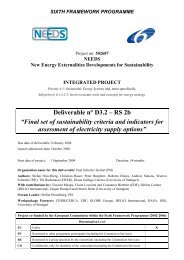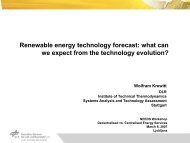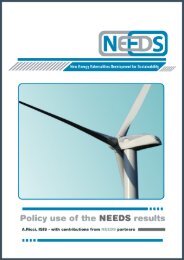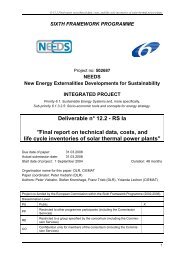Generation, of the energy carrier HYDROGEN In context ... - needs
Generation, of the energy carrier HYDROGEN In context ... - needs
Generation, of the energy carrier HYDROGEN In context ... - needs
You also want an ePaper? Increase the reach of your titles
YUMPU automatically turns print PDFs into web optimized ePapers that Google loves.
NyOrka Page 37 12/18/2008Site preparation<strong>In</strong>vestment storageoperation<strong>In</strong>vestment Reformer, compressor, dispenserMaintenance infrastructure€ per kg hydrogen18 €16 €14 €12 €10 €8 €6 €4 €2 €CUTE ∅ status quoCUTE ∅ status quoCUTE ∅ status quo0 €min average maxFigure 18 Steam Reformer scenario 600 Nm3/h and 170 plants; cost per kghydrogen. Electricity cost = 10 ct/ kWh; natural gas cost = 5 ct/ kWh; N2 cost = 0,5€/ Nm3, all using foreThe cost comparison made within <strong>the</strong> CUTE /HyFLEET:CUTE project indicates thatnon-operational cost are likely to decrease in <strong>the</strong> future. This is due to decreased cost <strong>of</strong><strong>the</strong> o<strong>the</strong>r than operational cost as a result <strong>of</strong> up-scaling and learning curve effects anddecrease <strong>of</strong> operational cost resulting from an increase <strong>of</strong> <strong>energy</strong> efficiency in <strong>the</strong> future.On <strong>the</strong> o<strong>the</strong>r hand, if <strong>the</strong> electricity that is used to operate <strong>the</strong> electrolysis is ra<strong>the</strong>rrescued or “dumped pðewer” ra<strong>the</strong>r than bought, <strong>the</strong> price may become even lower.4.5.1 The potential role <strong>of</strong> hydrogen in a future <strong>energy</strong> supply system<strong>In</strong> January 2007 <strong>the</strong> project Encouraged 43 published its results from looking into <strong>the</strong>potential import <strong>of</strong> gas, hydrogen and electricity to Europe. The report builds on <strong>the</strong> Hy-Ways scenarios for hydrogen which are still in formulation. The forecast outlines twoalternative market development scenarios – High (corresponding to ‘Very optimisticscenario’) and Low (‘realistically optimistic scenario’) until 2050. The most pessimisticscenario would <strong>the</strong>n be <strong>the</strong> one which is foreseen in <strong>the</strong> EU Energy trends policy paper(2003): European Energy Outlook and Transport – Trends to 2030, which states that oilproducts keep <strong>the</strong>ir market share at least until 2030. Hydrogen is nei<strong>the</strong>r mentioned foruse in stationary CHP application nor as fuel for transport 44 . According to <strong>the</strong> pessimisticscenario <strong>the</strong> penetration would be 0 by 2030. A different scenario was presented from <strong>the</strong>Hy-Ways project, s European Hydrogen Roadmap 45 as shown in Table 1543 Energy corridor optimisation for European Markets <strong>of</strong> Gas, Electricity and Hydrogen (ENCOURAGED, project no:006588, 6 th Framework Program, Scientific Support Policy (3.2). Project manager Martin Wietschel, Frauenh<strong>of</strong>er ISI44 European Commission Directorate-General for Energy and Transport, 2003: European <strong>energy</strong> and transport trends to2030. Prepared by National Technical University <strong>of</strong> A<strong>the</strong>ns, E3Mlab45 Hy-Ways, European Hydrogen Roadmap available at: www.HyWays.de







